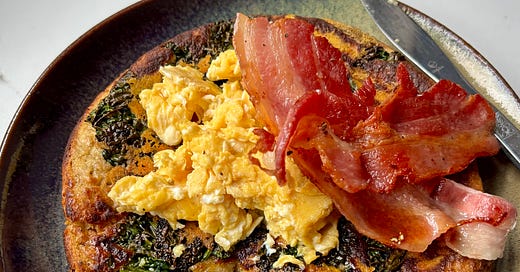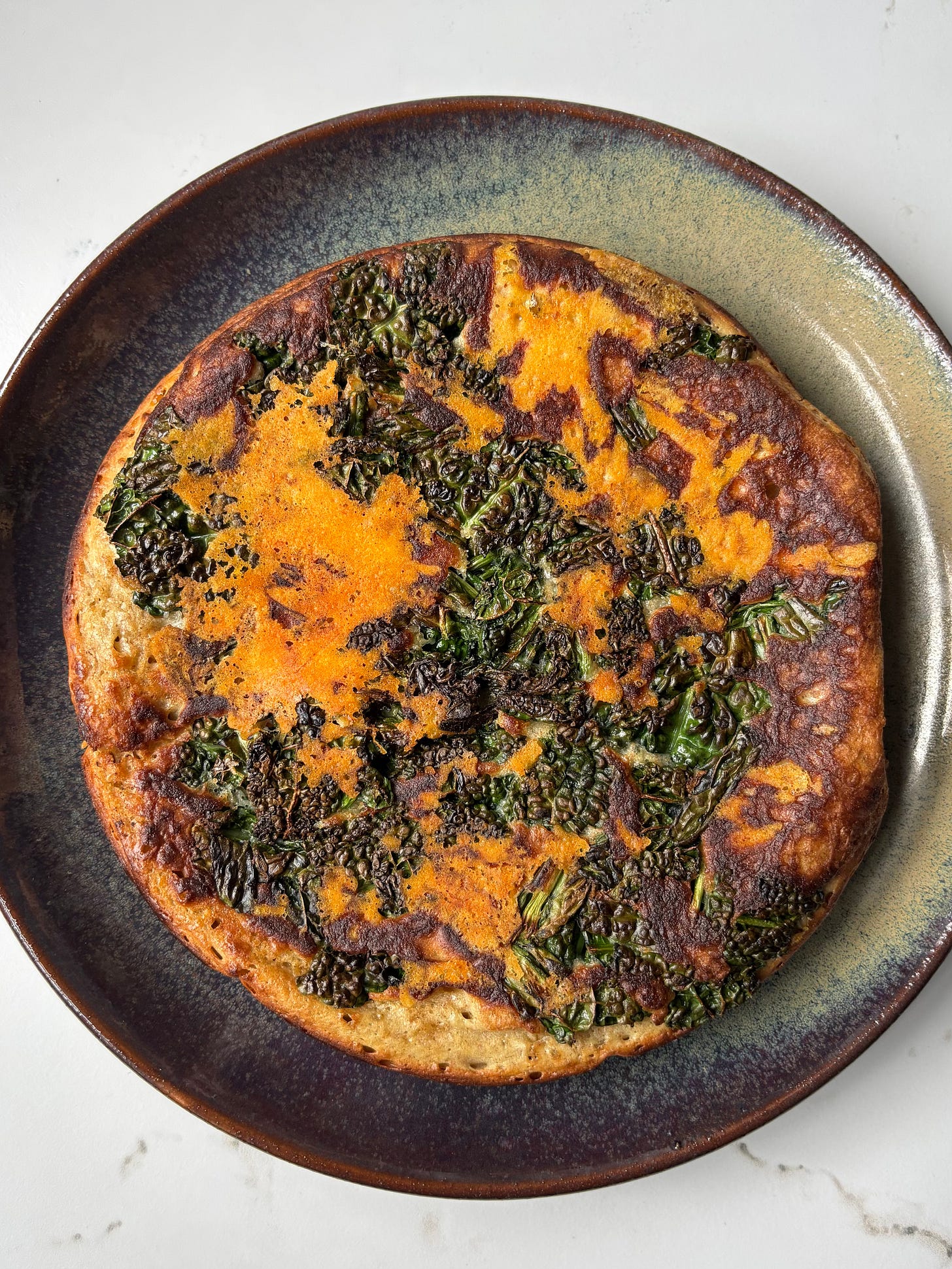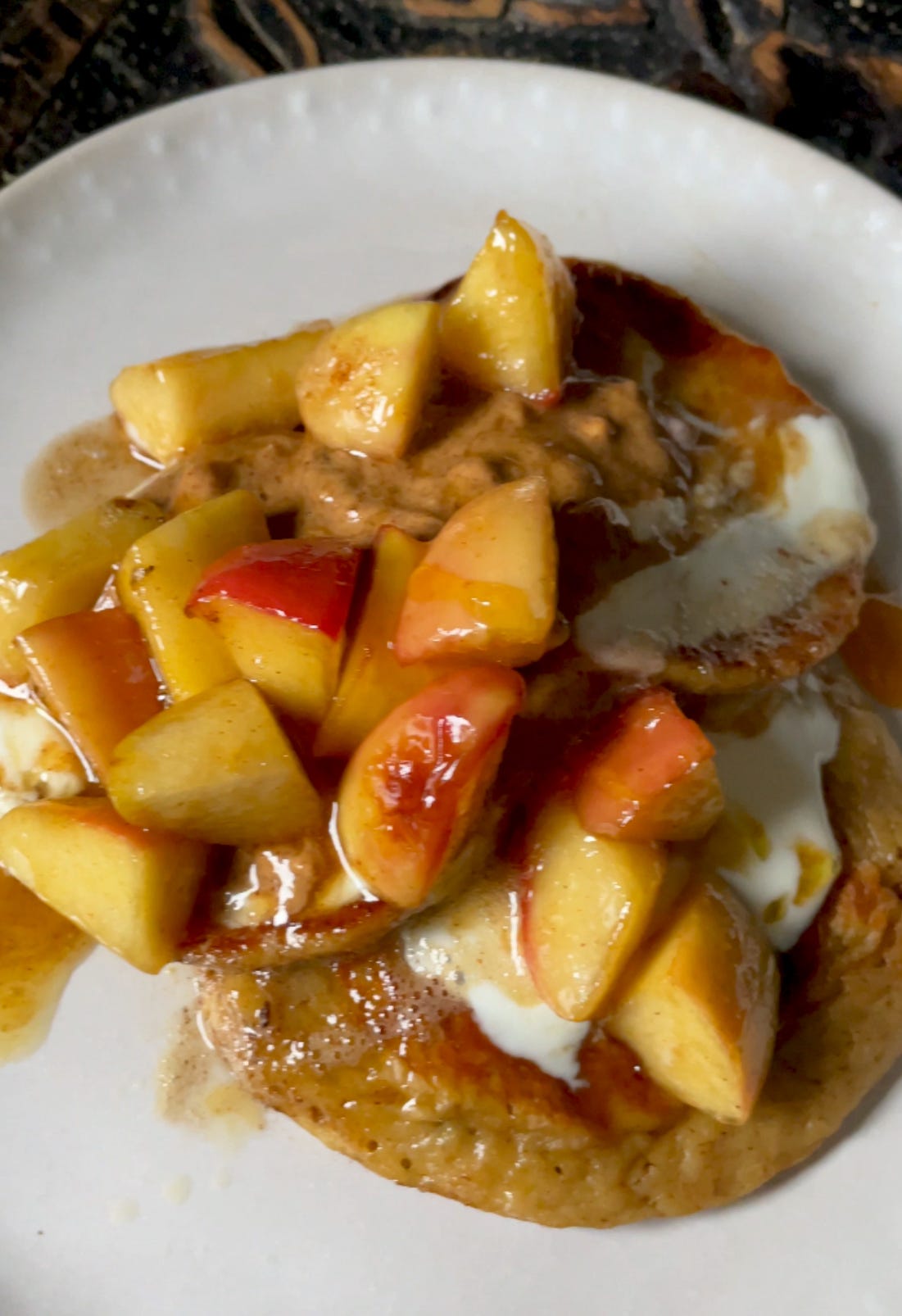Pancake day is next week so today feels like the ideal time to share a sourdough discard pancake recipe I’ve been tinkering with for a few months. At the end of last year, I went on a trip to New York with my partner and we spent most of our time eating and drinking our way around Brooklyn. One of the highlights was a thick, fluffy sharing pancake we ate at Vinegar Hill House. The pancake is a staple of the menu but the fruit baked into it changes seasonally. The version we had was a bit like a tarte tatin with thin slices of caramelised apple hidden underneath. What looked unassuming, a single disc of golden pancake with a pat of butter melting slowly as it reached our table, was something truly special.
I’ve cooked many pancakes in my lifetime, as I’m sure you have too. I remember making scotch pancakes with my mum as a treat for breakfast as a kid, and we usually enjoyed sugar and lemon crepes in the evening on pancake day. There’s a place for both styles, as there is American-style buttermilk pancakes which have been my jumping off point for many of the pancake recipes I’ve written for work. Most recently, my recipe for cottage cheese and chive pancakes with hot-smoked trout are on the cover of Delicious magazine this month. But a singular, thick pancake hadn’t crossed my mind. So back at home, I couldn’t resist giving it a go.
I took some inspiration from Vinegar Hill House’s recipe (which a google search happily helped me find) to get me going but I wanted to make it simpler for cooking at home, and without relying on the oven (as it’s excessive to turn it on to cook a single item). Then I wanted to make the recipe more flexible. I played around with using sourdough starter, which works if you’re a regular sourdough baker, but also wanted a version that uses standard raising agents. Most of all, I wanted the recipe to work for both sweet and savoury toppings. While I have a sweet tooth, I appreciate the depth of flavour from a buckwheat crepe or a savoury pancake much more than the syrup doused kind these days.
For this recipe, I’ve suggested blueberries for sweet. A classic for pancakes, they hold their shape when cooked in batter and provide pops of tart, sweetness. Now you may be thinking, blueberries are not in season at the moment so why are they being used by someone who claims to be a conscious cook. Which is fair, but the answer is, I usually have a pack of blueberries in the freezer. Frozen fruit and veg are often forgotten but are a great option. My favourite version of this pancake is savoury though. Some lightly wilted cavolo nero looks beautiful suspended in the batter and adds a tender bite, then some cheddar adds umami and an irresistible toasted cheese crispy top. But you could swap in any greens you have, some sautéed leeks or caramelised onions. Other cheeses also work well.
Here is the recipe, I hope you enjoy it.
Thick, fluffy sourdough discard pancakes
Makes 2, serves 2-4
(you could eat a whole one for dinner with savoury toppings, or half for breakfast or a dessert)
120g sourdough discard (ideally fresh)
60g rye or wholemeal flour
60g plain flour
220ml milk
1 tbsp golden caster sugar (if sweet)
2 medium eggs, separated
½ tsp bicarbonate of soda
½ tsp salt
Butter, for frying
TOPPINGS
100g blueberries (defrosted frozen berries when not in season)
Maple syrup, to serve
OR
60g cavolo nero, sauteed for a few minutes in butter until wilted
70g cheddar or wensleydale
Scrambled eggs or crispy bacon, to serve (optional)
1 If you’re making the pancakes for breakfast, start the batter the night before. But if you’re making them for lunch or dinner, you can start 2 hours before. In a medium bowl, whisk together the sourdough starter, flours, sugar (if sweet), milk and egg yolks. Cover with a tea towel and chill overnight or leave at room temperature for 2 hours.
2 In the morning or 2 hours later, lightly beat the egg whites (just until they’re a bit frothy) and add to the pancake batter with the bicarbonate of soda and salt.
3 Heat a small frying pan (mine has a 17cm base and measures 20cm at the top) over a medium-high heat and add a knob of butter. Once melted and sizzling, pour in the pancake batter and reduce the temperature to medium. Cook for about 5 minutes until bubbles have risen to the surface of the pancake and the edges are starting to set, looking a bit like the texture of a crumpet. Sprinkle the topping of your choice into the center of the pancake then use a rubber spatula to carefully, but firmly flip the pancake over. Cook for another 2-3 minutes until set.
4 Turn out onto a plate and serve with more butter. I drizzled some maple syrup over the blueberry pancakes, and served the cheddar and greens pancake with scrambled egg and regeneratively farmed bacon.
No sourdough starter? Or need a shortcut?
Instead of sourdough discard, double the quantity of rye or wholemeal flour, add an extra 50ml milk and add ¼ tsp baking powder. You don’t need to leave the batter to rest but if you’d like to prepare the batter before you make other things (like the toppings), you can mix the ingredients as in step 1 and set aside. Only add the egg white, bicarb and salt.
Next, I’m sharing a solution to porridge leftovers that happens to come in pancake form. If you’re a porridge fan but sometimes misjudge the amount to make (which is easy to do if you eyeball it like me), these pancakes are for you. You can adjust the recipe depending on how much porridge you have – increasing or decreasing the amount of flour, then adding enough milk to get the batter to a soft dropping consistency. Keep any leftover porridge in a container in the fridge for up to 4 days before turning into pancakes.
Leftover porridge pancakes with brown butter apples
Serves 2
100-200g plain flour
½ tsp baking powder
1 tbsp caster sugar
pinch of cinnamon
1 medium egg
About 100ml milk
1 apple, cored and cut into 2cm chunks
Yogurt, to serve (optional)
1 Weigh the leftover porridge in a bowl and add enough plain flour to get to 200g (if you already have 200g porridge, double this recipe). Stir in the baking powder, caster sugar, a pinch of salt and a pinch of cinnamon. Crack in the egg and add a splash of milk. Mix to combine then continue to add milk, a little at a time, until the batter reaches a dropping consistency (it drops off the spoon easily but holds its shape).
2 Heat a large frying pan over a medium heat, add some butter then spoon in about a heaped tablespoon of the batter for each pancake. Fry for 1-2 minutes until set around the edges and bubbles rise to the surface in the middle. Flip and cook for another minute on the other side. Repeat until you’ve used all the batter.
3 Meanwhile, melt the butter over a medium heat until it turns nutty and golden, swirling the pan every now and then. When it’s nearly ready it will be spluttering less and making less noise. Add the apples and cook for about 5 minutes, stirring regularly, until soft. Drizzle in some honey and stir to coat. Serve the brown butter apples over the pancakes. They’re great with a dollop of yogurt too.
BATCH COOK TIP
Pancakes are perfect for freezing. Once cooked and cooled, put the pancakes in a container in the freezer. Pop in the toaster to warm through from frozen (I really enjoy the way the pancakes gain a crisp edge from toasting) or reheat in a dry frying pan over a medium heat.
Extra Bites
Here are some more pancake recipes I’ve written for Delicious over the past few years.
Recommendations
I wanted to share a few great exhibitions currently on in London with you. First, Somerset House has an exhibition called SOIL: A World At Our Feet at its Embankment Galleries until 13th April that I went to see a few weeks ago. Soil seems like an unexciting topic on the surface, but much like soil itself, when you look into it you reveal a whole world to be discovered. Modern farming methods and chemical fertilisers have depleted the world’s soil, and it is now widely agreed that improving our soil quality is key in combating climate change. A thriving soil microbiome (the diverse community of microorganisms within it) helps plants (including our crops) grow better, captures carbon and naturally cleans up pollutants. This exhibition really gets you to think about soil as more than just dirt. Its creative, multi-sensory exhibits bring the undergrowth to life and highlights the scale of its importance to our everyday lives.
If you can’t make it down to London, or you’d like to explore the topic further, Farmerama have just launched a podcast series in line with the exhibition. Which you can listen to on their website through the link above or on your usual podcast provider.
Another exhibition worth a visit is Taste of Tomorrow at The Mills Fabrica in Kings Cross. Just in a single room, this exhibition won’t take lots of time from your day but is filled with really interesting information. It’s showcasing some groundbreaking innovations that could transform our food system and shape what we’ll be eating in the next 25 years. Plus there’s a great little shop with eco products. On until the end of July at the weekends, it’s well worth a visit - find out more and get free tickets here.
Discounts
If you’d like to serve your pancakes with high welfare, native breed pork bacon like I have, I recommend Pipers Farm. It contains no artificial additives or preservatives and the rashers have a great thickness. Their pigs are truly free range and you can taste the difference. For 10% off your first order at Pipers Farm, use the code EMILYGUSSIN10







